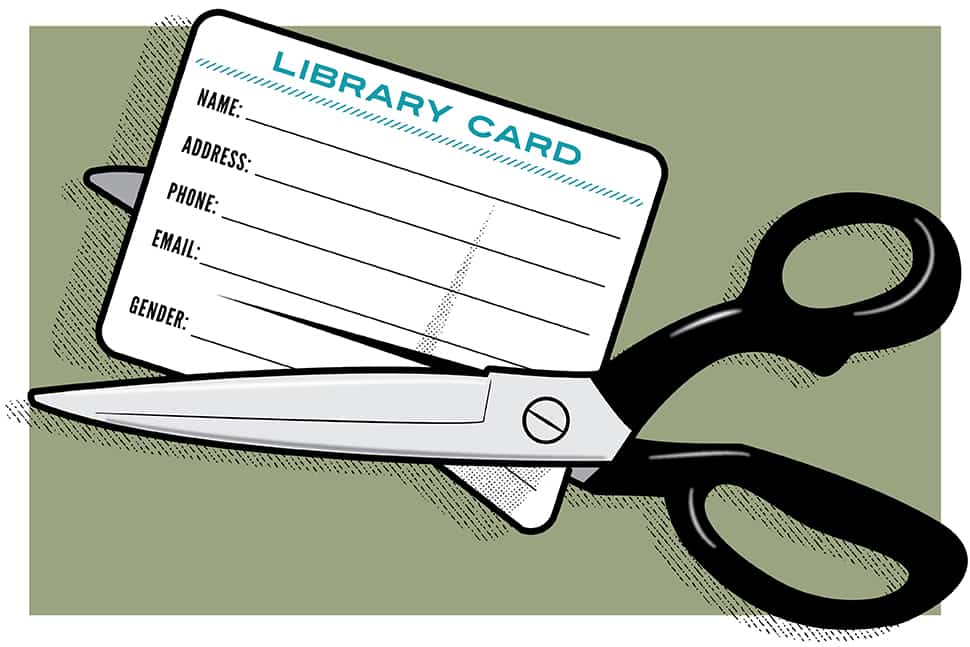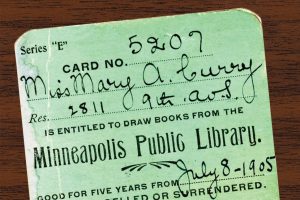
What do we use ‘gender’ for?”
That might sound like the opening volley of a gender-studies lecture. But when Erin Shea, supervisor of Ferguson Library’s Harry Bennett and Weed Memorial and Hollander branches in Stamford, Connecticut, wondered it aloud at a staff meeting last October, she was waxing practical, not theoretical.
Specifically, she was questioning a common procedure followed by her library and many others: requiring patrons to specify their gender on library card applications. “I expected to hear that we used [gender data] for statistics,” she says. “But the answer was: ‘Huh. We don’t really use it.’” Ever since, applying for a library card at Ferguson has meant submitting one’s name, birth date, address, phone number, and email address—and nothing else.
Just two states away, Joel Nichols, administrator for data strategy and evaluation at Free Library of Philadelphia, had a very different experience when advocating for a gender-free library card application a couple of years ago. “My department was saying, ‘We’re never going to use this gender information,’” he says. “But there were strong objections from other people” based on “the notion that this data might somehow, someday be worth something.”
Though it’s the official policy of Free Library of Philadelphia to process any library card application where the gender field is left blank, the paper form still asks applicants to choose “male,” “female,” “self-identified,” or write something else on the line provided.
The Gay, Lesbian, Bisexual, and Transgender Round Table of the American Library Association (ALA) has since 2015 recommended that libraries refrain from collecting information about patrons’ gender identities if that information is not truly needed to provide service. Four years later, some libraries have followed this recommendation, others haven’t, and still others have never collected gender information to begin with.
At the 2019 Midwinter Meeting in January, ALA Council passed a resolution to address the proposed definition of sex under Title IX by the US Department of Health and Human Services and the Justice Department, and affirm the Association’s support of civil rights protections for people of diverse gender identities. “ALA is committed to diminishing social exclusion, stigmatization, and underrepresentation within the communities served by libraries through an increased understanding of gender,” the resolution states. “[ALA] encourages libraries to create welcoming and inclusive spaces to meet the information needs of people of diverse gender identities.”
Advocates say having a data field for gender at best singles out transgender patrons and signals that they are not welcome in the library, and at worst can lead to harassment or physical violence if patrons are forced to disclose their transgender status.
“I see gender on the library card as a barrier to access that I personally am working to undo,” Nichols says. “It is slowly changing.”
‘A welcoming and safe space’
Removing gender from library card applications was not the first step that Ferguson Library took to help transgender patrons feel more welcome. That process began in 2016, when Shea converted her branch’s existing single-user restrooms into all-gender restrooms. “I was like, ‘This is low-hanging fruit,’” she recalls. “We just had to buy new signs.”
Afterward, “we did get pushback [from patrons], but it wasn’t coming from a place of hate. It was coming from a place of ignorance,” she says. “I hadn’t really taken time to educate the staff about why this was happening, and the staff in turn are the ones who educate the public.” So she invited a presenter from Norwalk, Connecticut–based Triangle Community Center, a provider of LGBTQ programs and services, to speak to her staff about ways to be more gender inclusive. It was the presenter, a transgender man, who introduced the idea that gender seldom truly needs to be specified or collected. “It was easy to see how that was part of our strategic plan—to promote the library as a welcoming and safe space where all are included,” she says. “I feel very grateful to work here, because everyone was like, ‘Oh yeah, that’s a great idea.’”
I expected to hear that we used [gender data] for statistics. But the answer was: ‘Huh. We don’t really use it.’—Erin Shea, supervisor of Ferguson Library’s Harry Bennett and Weed Memorial and Hollander branches in Stamford, Connecticut
Since gender has disappeared from the library’s card applications, she adds, the only feedback she’s gotten has been positive: After the Stamford Advocate newspaper ran a story about the library’s decision, a local mom called to say thanks.
Shea believes the change is having additional positive effects, even if they’re not immediately apparent. “Lots of people are not going to notice the change, but the people it matters to will notice, and even if they don’t comment on it, those are the people we made the change for,” she says.
Approaches to avoid misgendering
Conversely, some libraries are adding—rather than subtracting—a particular data field from their applications in hopes of making all patrons feel more welcome.
“We are adding ‘preferred name,’” explains Deb Sica, deputy county librarian for Alameda County (Calif.) Library. The change, which is under way, will allow any patrons—not just transgender ones—to indicate the name by which they wish to be addressed by library staff.
“It’s always a little off-putting when you have a specific name [you like to be called], and you’re called your official name during a library transaction. There’s an instant divide, for everyone,” Sica says.
The change came about both out of a desire to support the transgender community and to enhance the overall patron experience. “Our library wants to become less transactional and more personal,” Sica explains, “and this is part of that initiative.”
At San Antonio Public Library, patrons whose preferred names don’t match the name on their IDs aren’t questioned about it. “It doesn’t matter,” says Assistant Director for Public Service Dale McNeill. “If they fill out an application and it says ‘Julia,’ and we look at their ID and it says ‘John,’ we tell them, ‘I have to put in your record the name that’s on your ID. However, whatever name you prefer, we’ll put that in the alias field, and when we speak to you, we’ll use that name.’ And when the person picks up holds, they’ll be under that name. I think most people feel like that makes sense.”
In addition, he urges staff members to refrain from using “sir” or “ma’am” when speaking to patrons, particularly over the phone, because it can be easy to misgender someone—whether the person is transgender or not. “What I tell staff is, ‘No matter what your grandma told you, try really hard not to say ‘sir’ or ‘ma’am.’ Find a way to say, “It’s really been a pleasure to speak with you,” and then just place your lips together.’”
He tells staffers, too: “I’m not asking you to do something special because this person is transgender. I’m asking you to just be a nice person. Nobody likes to be misgendered.”


